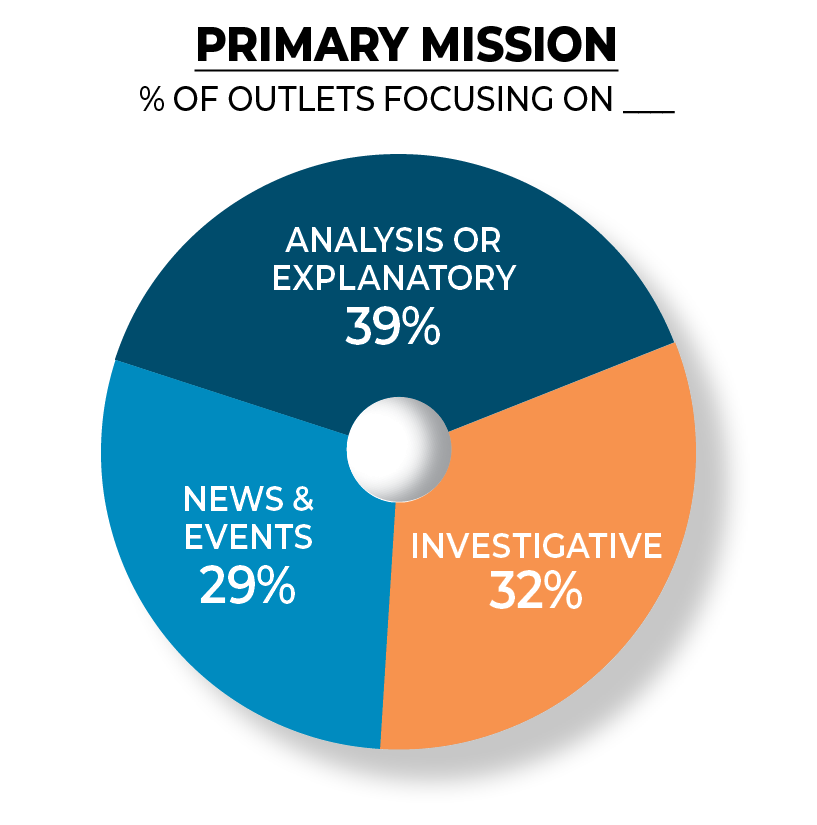INN Index 2022: Enduring in crisis, surging in local communities
Quality & Purpose of Coverage
Local news focuses on civic engagement
Defining and illustrating impact is one of the biggest challenges facing both emerging and established nonprofit journalism organizations. As nonprofit newsrooms are called on to demonstrate their impact – whether to funders, board members, supporters or staff – they have developed their own impact priorities and ways of measuring their work.
For the first time, the INN Index survey asked outlets to identify the impact they most seek to have through their journalism. The top-priority impact sought across the field is to build and expand knowledge around a complicated issue or topic, and also often mentioned is reflecting people’s perspective and lived experiences.
Local outlets are more likely than other types of newsrooms to focus on enabling or inspiring people to get involved in civic life.
Take for instance City Bureau, a local outlet based in Chicago that defines itself as a “nonprofit civic media organization.” Darryl Holliday, co-founder and now co-executive director of national impact, says in this INN case study: “Imagine if the success of a newsroom were measured by the quality of civic action informed and inspired by its reporting.” Today, City Bureau defines the key pillars of its impact as civic knowledge, information economy skills, generative relationships, and opportunities to engage in civic life. City Bureau is now bringing its reporting and impact approach to other local news markets around the country.
What does impact tracking within a nonprofit news outlet look like in practice? Jump here to see INN’s case studies on how four nonprofit news leaders are defining and measuring their impact.
Newsrooms covering national, global, state or regional issues largely focus on building and expanding knowledge around a complicated issue or topic. Investigative outlets are more likely to say “reveal or prevent corruption or abuse of power” is their primary impact area, whereas outlets that focus on producing daily or weekly news are more likely to focus on “reflecting people’s perspectives and lived experiences.”
Understanding the different buckets of impact will be critical in the coming years, as attention shifts from questions around the field’s stability toward how this stabilizing field can maximize its impact and service to the public.
The quality and character of nonprofit news stands out

While some nonprofit outlets focus on reporting the news of the day, the sector can primarily be understood as contributing in-depth, time-intensive news – investigations, enterprise, and explanatory reporting. Many focus on public policy issues.
Since 2017, the field’s focus on investigative and explanatory journalism has remained consistent, with a slight increase year over year in the share of explanatory reporting and declines in strictly investigative shops. Today, about a third of the field focuses on investigative journalism. And even outlets not strictly investigative demonstrate a commitment to depth: Fieldwide, 78% of all outlets employ or contract with at least one investigative journalist or editor, and 70% of newsrooms conducted at least one FOIA/public info request in the last year.
Nonprofit news targets underserved communities
Many nonprofit news outlets say they produce this in-depth journalism for populations historically underserved by commercial media, including people of color, rural and low-income communities.
About a quarter of all nonprofit outlets (28%) – most of them local – target low income populations. Nonprofit outlets also focus on providing services and coverage for changemakers, focusing on elected officials and policy makers (29%), community organizers and activists (25%), and civic leaders (20%). About a quarter say rural communities are a primary target audience of their coverage. INN’s Rural News Network (RNN) is a reporting consortium connecting more than 60 of these outlets serving rural communities – leveraging a network approach to sustainability, story generation and dissemination.
About a quarter (26%) of outlets surveyed say their primary mission is to serve communities of color. Startups, mostly local, are driving this focus. Nearly one-third of the 55 outlets that launched in 2020 and 2021 say serving communities of color is a primary mission, and more than half make specific efforts to serve these communities even if it isn’t the primary mission.
INN’s research shows efforts to serve communities of color range from launching new coverage areas and building partnerships with other news outlets to using new audience engagement and distribution strategies (including podcasts, niche print products and SMS or texting services).
Dallas Free Press is one of many nonprofit news outlets leveraging different platforms, such as texting, to serve people of color. As the outlet’s executive director, Keri Mitchell, said in a recent INN Q&A, community leaders told the Free Press: “‘If you try to do this with email, you’ll fail.’ They said we needed to get information directly to people’s phones. They also told us that if we didn’t have Spanish-language content, we would fail. So before we even had a website, we launched our texting service in both neighborhoods, and in both English and Spanish.”
Charlottesville Tomorrow built a partnership with Vinegar Hill Magazine, an independent African American publishing company, in order to better serve Black communities in Charlottesville. Together with other community partners, the two Virginia outlets launched the Charlottesville Inclusive Media Project in order to co-produce and co-publish new projects focused on highlighting Black perspectives and experiences. Jump to INN’s Q&A with Charlottesville Tomorrow to learn more.
